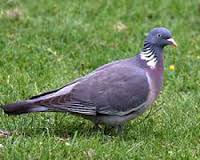Pigeons are classified into two families: Columba, fairly large animals with a wide, straight cut tail and Streptopelia, slender, small birds with long pointed tail.
T he common wood pigeon (Columba palumbu)s in our region is the largest bird of Western Europe. The body measures 40-43 cm and the tail. 11-15 cm The wingspan is 68-80 cm. They are trained, good flyers with lots of muscle mass. Think of racing pigeons and homing pigeons. An adult wood pigeon weighs about 500 grams.
he common wood pigeon (Columba palumbu)s in our region is the largest bird of Western Europe. The body measures 40-43 cm and the tail. 11-15 cm The wingspan is 68-80 cm. They are trained, good flyers with lots of muscle mass. Think of racing pigeons and homing pigeons. An adult wood pigeon weighs about 500 grams.
The beak is yellow with a pink base among white nostril cere. It is up to the base covered with a cere and narrowed in the middle.
Pigeons drink in contrast to most of the birds by immersing the lower beak and to suck up the water.
The eyes are yellow, and pink the pair of legs.
The basic color is blue-gray. The breast is purple pink, the sides of the neck are green purple, with a wide white neck blend. The tail has at the top a wide black belt, and transverse to its lower end a light colored band. It is the only pigeon with on the upper side of the central wing bending back wing stripes.
A juvenile is a youthful, non - pubescent copy. They do not have a distinctive white neck spot or green purple feathers on the side of the neck (yet).
The pigeon flies a powerful and straight flight with a lot of noise and flapping wings. The wings fold above and below the body to touch each other!
After landing, the tail goes first up and then down. This indicates that the bird intends to stay there temporarily.
When stepping they move their heads later than corporal. It looks like following it. This would promote the vision and depth perception.
They have a 6th sense for magnetic field detection. In their mouths are two receptors that are very rich in to magnetism sensitive iron. They are arranged so that they can pass on a three-dimensional signal to the brains. They use it for their orientation and retrieval of their nesting sites.
Wood pigeons eat plant material, such as green leaves, seeds and especially grains and legumes.
Cocks usually forage in the early morning and hens usually in the later evening, to 15-20 km from the nest. (Foraging: (go) to find and collect food.)
Foraging happens often in groups (flocks), according to a certain order. The subordinate birds pecking slower than prominents. Most food is taken in the late afternoon, 70% between 15:00 and 18:00. The daily food requirement is between 80 and 90 grams. In the crop, the food is stored and (pre) digested.
Typically in pigeons, and different by type, are the gurgling and cooing sounds.
Pigeons cooing always in courtship (courtship dance) and do hereby strutting movements.
Between species, urban and rural pigeons there is a large variation in the breeding season (February-March).
A pigeon nest consists of a platform of twigs, straw etc., brought by the cock and ordained by the hen. The clutch includes one to two, sometimes three eggs, which are incubated by both parents. The cock stays in daytime, the pigeon nests at night for about 2.5 weeks.
Pigeons breed three times a year.
The parents carry their young with pigeon milk (or crop milk). This is a cheese -like slurry, formed by the mucous membrane of the head under the influence of the hormone prolactin, which also regulates the milk production in mammals. When feeding the squabs protrude their beak into the beak corner of the parent who squeezes the crop content into the beak of the squab.
Feeding happens the first day on the hour. After eight days, in the morning and evening, and it’s done in turn by both parents.
Lots of eggs and squabs are taken by jays, magpies, rooks, stoats, crows and rats. But the main cause of death among young is food shortage.
Juveniles and adult pigeons have hawk as an enemy.
They reside in forests or tree rows with fields.
Wood pigeons roam in the winter, a small part migrates in a southwesterly direction, but most of the wood pigeons stay here all year.
A former neighbor regularly sprinkled some grain in a feeding area. And occasionally he blew a shot or two in the flock. Then all the neighbors ate pigeon.
